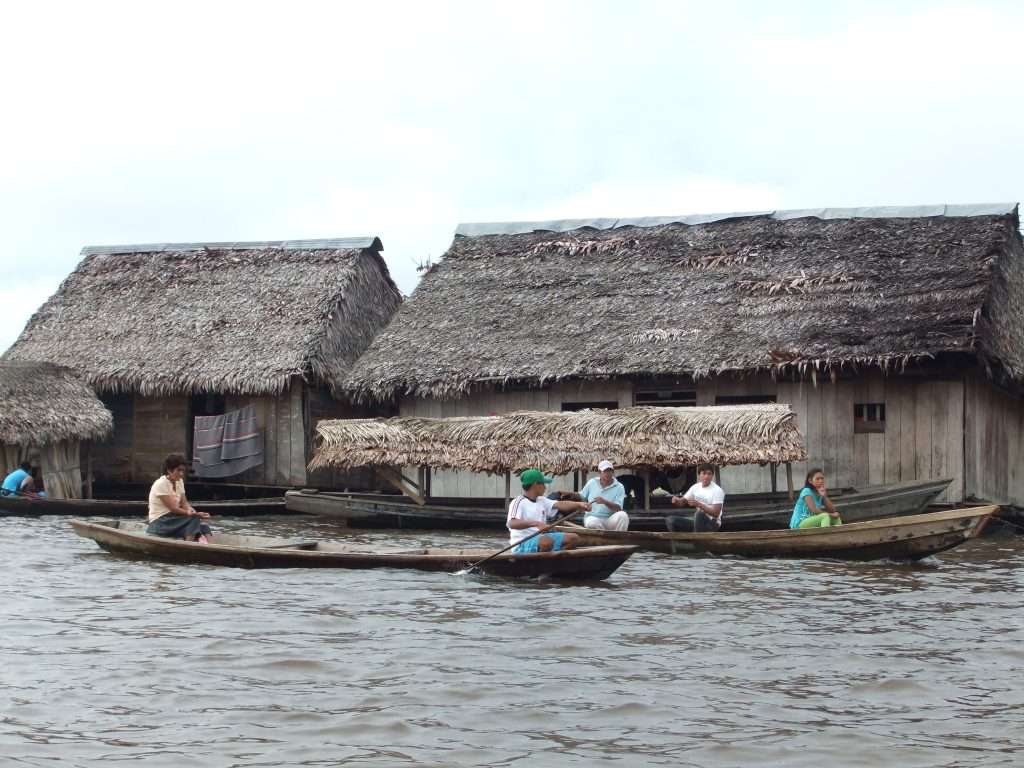The Peruvian Amazonia, rich in natural resources, stands as a testament to the dual nature of such assets. While these resources offer immense potential, they can also become burdens if not managed sustainably (Brooks., 2017). The Callería Native Community, located in the heart of the Peruvian Amazonia, showcases how to transform potential burdens into assets through the transformative environmental strategy of Community Forest Management (CFM). The forest is a treasure trove of biodiversity, it stands at a pivotal crossroads with over 2 million hectares lost in the last two decades (Walker et al., 2020).
Amidst this backdrop of degradation and deforestation, the indigenous communities, often at the receiving end of governmental corruption and external exploitation, are searching for sustainable solutions. A beacon of hope in this scenario is the Callería Native Community. Located in the heart of the Peruvian Amazonia, this community has transitioned from unsustainable logging practices to the transformative approach of Community Forest Management (CFM). Drawing from the success story of the Callería Native Community and insights from contemporary development theories, we present a compelling case for policy reform and the broader adoption of CFM (McKay, 2004). This transition is particularly significant in the Anthropocene Epoch, where human activities have a dominant influence on the environment (Thrive Project, 2023).

What is Environmental Sustainability Strategy?
Environmental Sustainability Strategy is an intricate framework that integrates a set of practices, principles, and values, all aimed at preserving the delicate balance of our planet’s ecosystems. Central to this strategy is the recognition that Earth’s resources are not inexhaustible. Every action, whether it’s resource extraction or waste disposal, has consequences, often extending far into the future (Skene, 2022). This strategy champions the efficient use of resources, minimizing waste, and promoting recycling or reuse wherever feasible. It’s not just about immediate benefits; it’s about adopting a long-term perspective, ensuring that the decisions of today don’t jeopardize the well-being of future generations (Thrive Project, 2023)
In places like the Peruvian Amazonia, the essence of this strategy becomes even more pronounced. The Amazonia, a vital cog in the global ecological machine, is under constant threat from activities like deforestation and illegal logging. Here, the strategy transforms from mere theory to practical application. The Callería Native Community’s shift towards sustainable practices, such as Community Forest Management (CFM), epitomizes the real-world impact of the Environmental Sustainability Strategy. By empowering these indigenous communities and placing a premium on biodiversity conservation, the strategy seeks to ensure that the Amazonia’s lush landscapes and diverse ecosystems thrive for centuries to come (Calero Valdez, 2022).
Moreover, this localized approach in the Amazonia resonates with broader global initiatives, notably the United Nations Sustainable Development Goals (SDGs). It’s a testament to how localized, community-driven actions can ripple outwards, contributing to global sustainability objectives. In essence, by embracing and implementing the Environmental Sustainability Strategy, communities like Callería are not just safeguarding their local environment but are also playing a pivotal role in global conservation efforts (Calero Valdez, 2022).

How Does Environmental Sustainability Strategy Uniquely Affect Rural Communities?
Rural communities, especially those in regions like the Peruvian Amazonia, have a profound connection to their environment. Their daily lives, traditions, and even their cultural identity are deeply intertwined with the natural resources surrounding them. The Callería Native Community’s success with Community Forest Management (CFM) underscores the transformative potential of empowering indigenous communities through sustainable practices.
In the Amazon region, Indigenous Territories (ITs) and Protected Natural Areas (PNAs) store more than half of the region’s carbon, emphasizing the significant role indigenous land management plays in conserving forests and reducing carbon emissions (Walker et al., 2020). The unchecked exploitation of resources, often driven by external entities, can lead to significant ecological and socio-economic consequences for these communities. Deforestation, illegal logging, and other unsustainable practices not only erode the natural environment but also the cultural and social fabric of these communities.
However, the adoption of Environmental Sustainability Strategy, as exemplified by the Callería Native Community’s transition to CFM, can lead to both ecological conservation and socio-economic revitalization. CFM, as a decentralized strategy, allows communities to share both responsibilities and rewards, ensuring that the benefits of conservation directly impact the community members (Calero Valdez, 2022). Such strategies not only ensure the sustainable use of resources but also empower communities, giving them a voice and control over their lands and resources.
CFM Benefits
- Economic Empowerment: The transition to CFM has brought about tangible economic benefits for the Callería Native Community, aligning with broader findings that forests contribute significantly to human well-being (Thrive Project, 2023). While the Amazon’s resources are invaluable, it’s essential to harness them in ways that ensure ecological balance and also bring economic gains. Stable incomes, new job opportunities, and community-driven revenue allocation have led to improved living standards. Funds generated from sustainable forest management have been reinvested in essential community needs, including food, education, and health infrastructure.
- Social and Cultural Revitalization: Beyond economic gains, CFM has fostered a sense of pride, unity, and cultural revitalization within the community. The collective management of forests has strengthened internal cohesion and reaffirmed the community’s deep-rooted connection to their ancestral lands, emphasizing the importance of local communities in reshaping power dynamics and leading sustainable initiatives, while prioritizing human welfare (Brooks, A., 2017.)
- Environmental Conservation: The Callería Native Community’s commitment to CFM underscores their role as environmental stewards. Sustainable forest management practices have not only halted deforestation but have also set the stage for forest regeneration and biodiversity conservation.
Moreover, the effectiveness of the Callería Native Community’s transition to CFM is underscored by compelling data. In 2016, Indigenous Territories (ITs) and Protected Natural Areas (PNAs) accounted for a remarkable 58% of the Amazon region’s carbon storage, underscoring the pivotal role of indigenous land management in carbon sequestration. This data not only emphasizes the profound impact of such management practices but also highlights the significance of the Callería Community’s sustainable initiatives (Walker et al., 2020). Additionally, between 2000 and 2015, deforestation rates outside ITs and PNAs were alarmingly five times higher than within these protected regions, further accentuating the the protective value of these areas.

Moving Forward
Empowering indigenous communities through CFM is pivotal for ecological balance. The Callería Native Community’s CFM success, backed by NGOs like AIDER and international support, exemplifies the transformative power of sustainable initiatives (Calero Valdez, 2022). Data from 2016 reveals that Indigenous Territories (ITs) and Protected Natural Areas (PNAs) stored 58% of the Amazon’s carbon, underscoring the importance of indigenous land management (Walker et al., 2020).
For broader adoption, recognizing the role of indigenous communities in conservation is essential. Collaborative efforts among governments, NGOs, and international bodies can ensure a sustainable future. The Callería Native Community’s CFM model can guide regions facing deforestation challenges. Empowering communities with resources and training is crucial for CFM’s success. Addressing power dynamics in the Amazon and fostering collaboration can amplify CFM’s success (Calero Valdez, 2022).
While the success of the Callería Native Community’s CFM model is commendable, it’s essential to recognize its limitations. The Amazon is a vast and diverse region, and what works for one community might not necessarily be applicable to another. The unique socio-economic, cultural, and environmental contexts of different communities can present varied challenges and opportunities. Therefore, we emphasize the need for comprehensive research on integrated approaches in the Amazon, similar to the CFM case study. Such research will provide a more nuanced understanding, allowing for the development of tailored strategies that cater to the specific needs of different communities. Only through rigorous study and analysis can we craft policies that truly benefit the diverse tapestry of the Amazon and its inhabitants.
Achieving the United Nations Sustainable Development Goals (SDGs) and How They Link to Environmental Sustainability Strategy
The success of the Callería Native Community’s CFM model serves as a tangible example of how localized efforts can contribute to global sustainability objectives, such as the United Nations Sustainable Development Goals (SDGs). Specifically, their CFM practices resonate with SDG 13 on climate action, by mitigating deforestation and reducing carbon emissions, and SDG 11 on sustainable cities and communities, by fostering socio-economic revitalization within the community. By highlighting the multifaceted benefits of CFM—from environmental conservation to economic empowerment—we can advocate for its wider implementation as a holistic and effective strategy for forest management that enriches both natural ecosystems and human well-being.
A Thrivable Framework
Gazing into the future of the Peruvian Amazonia, the Callería Native Community’s embrace of Community Forest Management (CFM) stands as a beacon of hope in conservation and sustainable development. The proactive involvement of indigenous communities and the sustainable utilization of the Amazon’s bountiful resources can play a pivotal role in enhancing biodiversity and reinstating a harmonious balance within ecosystems.
At THRIVE Amazonia, we spotlight pioneering sustainable endeavors. Our research and advocacy delve into the intricacies of these transformative shifts. We invite you to be an integral part of our journey. Don’t hesitate to engage with our informative blog posts and podcast series. Participate in our live webinars to delve deeper into the world of sustainability. Together, we can chart the course towards a more thrivable future.























